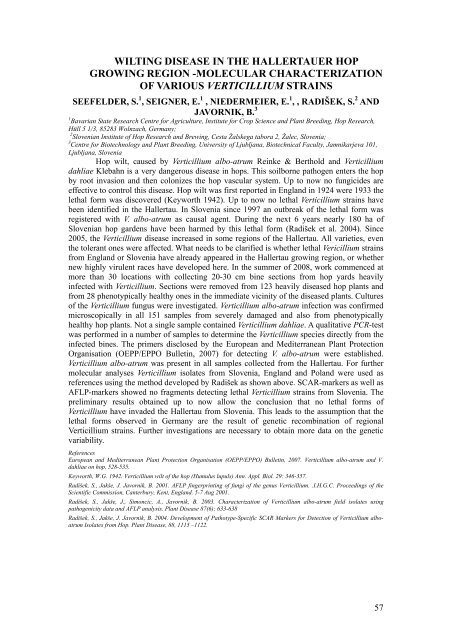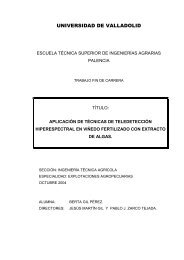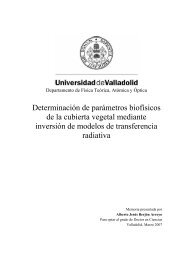10th INTERNATIONAL VERTICILLIUM SYMPOSIUM 16-20 ...
10th INTERNATIONAL VERTICILLIUM SYMPOSIUM 16-20 ...
10th INTERNATIONAL VERTICILLIUM SYMPOSIUM 16-20 ...
Create successful ePaper yourself
Turn your PDF publications into a flip-book with our unique Google optimized e-Paper software.
WILTING DISEASE IN THE HALLERTAUER HOPGROWING REGION -MOLECULAR CHARACTERIZATIONOF VARIOUS <strong>VERTICILLIUM</strong> STRAINSSEEFELDER, S. 1 , SEIGNER, E. 1 , NIEDERMEIER, E. 1 , , RADIŠEK, S. 2 ANDJAVORNIK, B. 31 Bavarian State Research Centre for Agriculture, Institute for Crop Science and Plant Breeding, Hop Research,Hüll 5 1/3, 85283 Wolnzach, Germany;2 Slovenian Institute of Hop Research and Brewing, Cesta Žalskega tabora 2, Žalec, Slovenia;3 Centre for Biotechnology and Plant Breeding, University of Ljubljana, Biotechnical Faculty, Jamnikarjeva 101,Ljubljana, SloveniaHop wilt, caused by Verticillium albo-atrum Reinke & Berthold and Verticilliumdahliae Klebahn is a very dangerous disease in hops. This soilborne pathogen enters the hopby root invasion and then colonizes the hop vascular system. Up to now no fungicides areeffective to control this disease. Hop wilt was first reported in England in 1924 were 1933 thelethal form was discovered (Keyworth 1942). Up to now no lethal Verticillium strains havebeen identified in the Hallertau. In Slovenia since 1997 an outbreak of the lethal form wasregistered with V. albo-atrum as causal agent. During the next 6 years nearly 180 ha ofSlovenian hop gardens have been harmed by this lethal form (Radišek et al. <strong>20</strong>04). Since<strong>20</strong>05, the Verticillium disease increased in some regions of the Hallertau. All varieties, eventhe tolerant ones were affected. What needs to be clarified is whether lethal Vericillium strainsfrom England or Slovenia have already appeared in the Hallertau growing region, or whethernew highly virulent races have developed here. In the summer of <strong>20</strong>08, work commenced atmore than 30 locations with collecting <strong>20</strong>-30 cm bine sections from hop yards heavilyinfected with Verticillium. Sections were removed from 123 heavily diseased hop plants andfrom 28 phenotypically healthy ones in the immediate vicinity of the diseased plants. Culturesof the Verticillium fungus were investigated. Verticillium albo-atrum infection was confirmedmicroscopically in all 151 samples from severely damaged and also from phenotypicallyhealthy hop plants. Not a single sample contained Verticillium dahliae. A qualitative PCR-testwas performed in a number of samples to determine the Verticillium species directly from theinfected bines. The primers disclosed by the European and Mediterranean Plant ProtectionOrganisation (OEPP/EPPO Bulletin, <strong>20</strong>07) for detecting V. albo-atrum were established.Verticillium albo-atrum was present in all samples collected from the Hallertau. For furthermolecular analyses Verticillium isolates from Slovenia, England and Poland were used asreferences using the method developed by Radišek as shown above. SCAR-markers as well asAFLP-markers showed no fragments detecting lethal Verticillium strains from Slovenia. Thepreliminary results obtained up to now allow the conclusion that no lethal forms ofVerticillium have invaded the Hallertau from Slovenia. This leads to the assumption that thelethal forms observed in Germany are the result of genetic recombination of regionalVerticillium strains. Further investigations are necessary to obtain more data on the geneticvariability.ReferencesEuropean and Mediterranean Plant Protection Organisation (OEPP/EPPO) Bulletin, <strong>20</strong>07. Verticillium albo-atrum and V.dahliae on hop, 528-535.Keyworth, W.G. 1942. Verticillium wilt of the hop (Humulus lupuls) Ann. Appl. Biol. 29: 346-357.Radišek, S., Jakše, J. Javornik, B. <strong>20</strong>01. AFLP fingerprinting of fungi of the genus Verticillium. .I.H.G.C. Proceedings of theScientific Commission, Canterbury, Kent, England. 5-7 Aug <strong>20</strong>01.Radišek, S., Jakše, J., Simoncic, A., Javornik, B. <strong>20</strong>03. Characterization of Verticillium albo-atrum field isolates usingpathogenicity data and AFLP analysis. Plant Disease 87(6); 633-638Radišek, S., Jakše, J. Javornik, B. <strong>20</strong>04. Development of Pathotype-Specific SCAR Markers for Detection of Verticillium alboatrumIsolates from Hop. Plant Disease, 88, 1115 –1122.57




